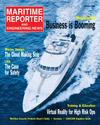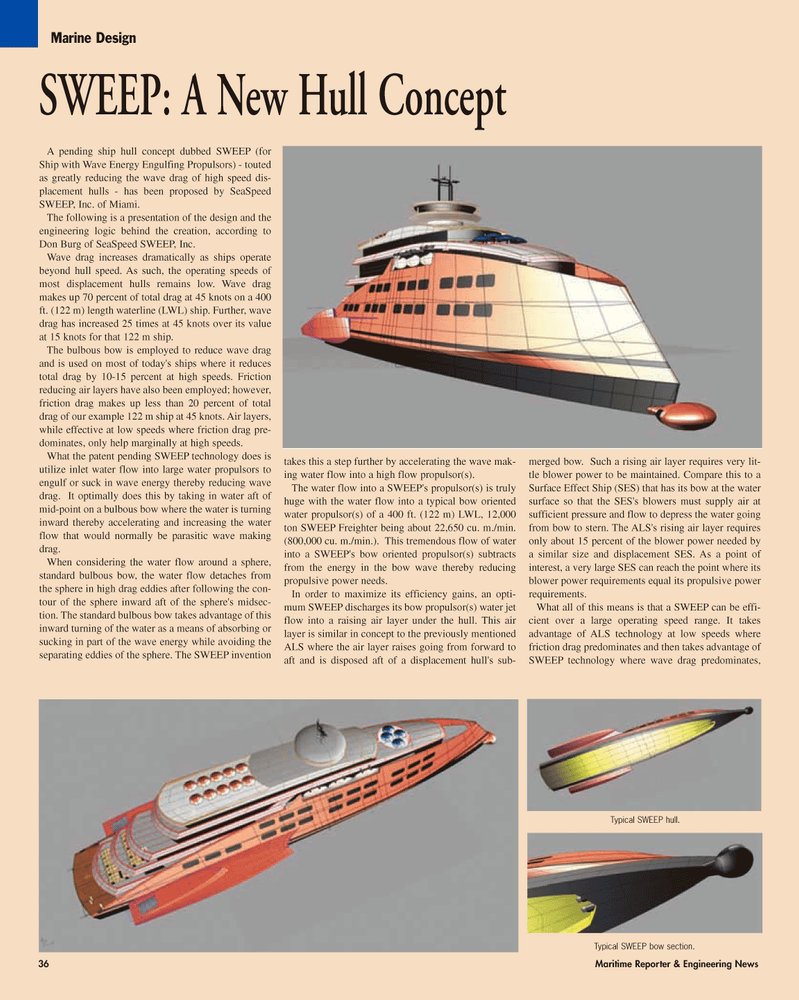
Page 36: of Maritime Reporter Magazine (October 2005)
The Marine Design Annual
Read this page in Pdf, Flash or Html5 edition of October 2005 Maritime Reporter Magazine
A pending ship hull concept dubbed SWEEP (for
Ship with Wave Energy Engulfing Propulsors) - touted as greatly reducing the wave drag of high speed dis- placement hulls - has been proposed by SeaSpeed
SWEEP, Inc. of Miami.
The following is a presentation of the design and the engineering logic behind the creation, according to
Don Burg of SeaSpeed SWEEP, Inc.
Wave drag increases dramatically as ships operate beyond hull speed. As such, the operating speeds of most displacement hulls remains low. Wave drag makes up 70 percent of total drag at 45 knots on a 400 ft. (122 m) length waterline (LWL) ship. Further, wave drag has increased 25 times at 45 knots over its value at 15 knots for that 122 m ship.
The bulbous bow is employed to reduce wave drag and is used on most of today's ships where it reduces total drag by 10-15 percent at high speeds. Friction reducing air layers have also been employed; however, friction drag makes up less than 20 percent of total drag of our example 122 m ship at 45 knots. Air layers, while effective at low speeds where friction drag pre- dominates, only help marginally at high speeds.
What the patent pending SWEEP technology does is utilize inlet water flow into large water propulsors to engulf or suck in wave energy thereby reducing wave drag. It optimally does this by taking in water aft of mid-point on a bulbous bow where the water is turning inward thereby accelerating and increasing the water flow that would normally be parasitic wave making drag.
When considering the water flow around a sphere, standard bulbous bow, the water flow detaches from the sphere in high drag eddies after following the con- tour of the sphere inward aft of the sphere's midsec- tion. The standard bulbous bow takes advantage of this inward turning of the water as a means of absorbing or sucking in part of the wave energy while avoiding the separating eddies of the sphere. The SWEEP invention takes this a step further by accelerating the wave mak- ing water flow into a high flow propulsor(s).
The water flow into a SWEEP's propulsor(s) is truly huge with the water flow into a typical bow oriented water propulsor(s) of a 400 ft. (122 m) LWL, 12,000 ton SWEEP Freighter being about 22,650 cu. m./min. (800,000 cu. m./min.). This tremendous flow of water into a SWEEP's bow oriented propulsor(s) subtracts from the energy in the bow wave thereby reducing propulsive power needs.
In order to maximize its efficiency gains, an opti- mum SWEEP discharges its bow propulsor(s) water jet flow into a raising air layer under the hull. This air layer is similar in concept to the previously mentioned
ALS where the air layer raises going from forward to aft and is disposed aft of a displacement hull's sub- merged bow. Such a rising air layer requires very lit- tle blower power to be maintained. Compare this to a
Surface Effect Ship (SES) that has its bow at the water surface so that the SES's blowers must supply air at sufficient pressure and flow to depress the water going from bow to stern. The ALS's rising air layer requires only about 15 percent of the blower power needed by a similar size and displacement SES. As a point of interest, a very large SES can reach the point where its blower power requirements equal its propulsive power requirements.
What all of this means is that a SWEEP can be effi- cient over a large operating speed range. It takes advantage of ALS technology at low speeds where friction drag predominates and then takes advantage of
SWEEP technology where wave drag predominates, 36 Maritime Reporter & Engineering News
Marine Design
SWEEP: A New Hull Concept
Typical SWEEP bow section.
Typical SWEEP hull.
MR OCTOBER 2005 #5 (33-40).qxd 9/29/2005 8:18 AM Page 36

 35
35

 37
37
